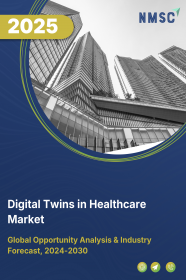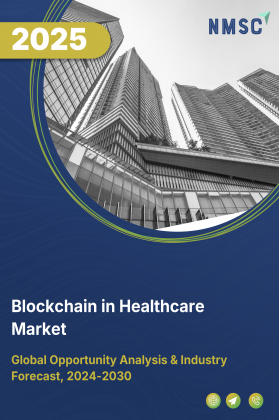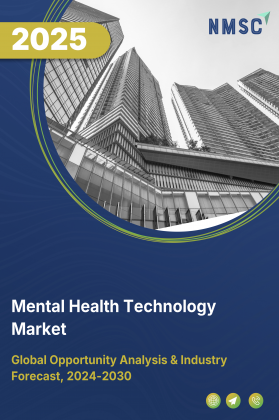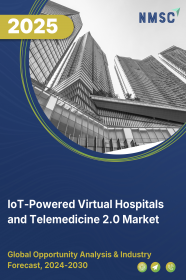
Digital Twins in Healthcare Market by Component (Software, and Services), by Application (Drug Discovery and Development, Personalized Medicine, Surgical Planning & Medical Education, Medical Device Design & Testing, Healthcare Workflow Optimization & Asset Management, Other Applications), by End User (Pharma and Biopharma Companies, Research & Academia, Healthcare Providers, Medical Device Companies, and Other End Users)- Global Opportunity Analysis and Industry Forecast 2024-2030
Digital Twins in Healthcare Market Overview
The global Digital Twins in Healthcare Market size was valued at USD 1.16 billion in 2024 and is projected to grow to USD 1.58 billion by 2025. Additionally, the industry is expected to continue its growth trajectory, reaching USD 4.69 billion by 2030, with a CAGR of 24.35% from 2025 to 2030.
The digital twins in healthcare market refers to the industry that involves generating virtual copies of physical healthcare assets, processes, or systems to mimic real-world counterparts. These digital replicas use data from different sources such as medical devices and electronic health records (EHRs) real-time insights and predictive analytics. Incorporating advanced technologies such as artificial intelligence (AI), the internet of things (IoT), and machine learning, digital twins help healthcare providers improve patient care, streamline operations, cut costs, and make better decisions in clinical and administrative areas.
Market Dynamics and Trends
The increasing investment in the healthcare infrastructure is driving the digital twin industry in the healthcare sector by providing the required technologies and resources to implement advanced digital solutions. As per the global health expenditure report published by the World Health Organization 2023 reveals that the global spending in the healthcare sector reached around USD 9.8 trillion in 2021.
This surge in investment is driving the hospitals and healthcare facilities to upgrade and expand along with the incorporating digital twin solutions. Digital twin technology helps in enhancing patient care, streamline operations, and improved efficiency enabling healthcare providers with real-time monitoring and predictive maintenance, thus boosting the market growth.
Also, the rise in the healthcare cost across the globe is increasing the need for ways to optimize the operations and reduce inefficiencies, thus driving the growth of the market. Digital twin platforms offer solutions by creating virtual models of healthcare processes and systems, allowing healthcare providers to test and improve treatment, and predict patient outcome more efficiently. This technology assist in lowering the overall expenses by improving efficiency and delivering better patient care, making it a preferable option for healthcare providers.
Moreover, the rising number of geriatric populations across the globe is significantly increasing the demand for advanced and personalized healthcare solutions, that in turn fuels the digital twins in healthcare market growth.
According to the United Nations, the proportion of people aged 65 and above is rising significantly and it is expected rise from 10% in 2022 to 16% by 2050. Digital twin solutions provide precise virtual models of patient that allows better monitoring, treatment, and management of chronic disease and age-related conditions.
Healthcare providers adopt these technologies for individual patient care, improved outcomes, and enhance the overall quality of life for the elderly populations, driving the growth of the market.
However, technology relies on the collection and analysis of large amounts of personal data, that raises concerns about privacy and security, restraining the digital twins in healthcare market demand.
On the contrary, the integration of 5G and edge computing in digital twin is expected to create ample growth opportunities for the market in the future. 5G networks and edge computing will provide sophisticated digital twin models that can be accessed and updated in real-time, allowing for more effective treatment and remote monitoring.
Market Segmentation and Scope of Study
The global digital twins in healthcare market report are segmented on the basis of type, application, end-user, and region. Based on type, the market is classified into process & system twin and product digital twin. Based on the application, the market is segmented into asset and process management, personalized medicine, drug discovery, and others. On the basis of end-user, the market is categorized into clinical research organization, hospitals & clinics, research & diagnostic laboratories, and others. Geographical breakdown and analysis of each of the aforesaid classifications include regions comprising of North America, Europe, Asia-Pacific, and RoW.
Geographical Analysis
North America dominates the global digital twins in healthcare market share and is potently expected to remain dominant in the industry throughout the forecast period. This is attributed to the high healthcare spending in the region enabling substantial investment in innovative and advanced healthcare solutions including digital twin.
The latest report of the Peter G. Foundation report states that the U.S. accounts for one of the highest healthcare costs in the world with its healthcare spending reached to USD 4.5 trillion that accounts an average to USD 13,493 per person in 2022. These high financials capacity drives healthcare organization to adopt advanced solutions such as digital twin to improve patient outcome and streamline operations.
Also, the increasing prevalence of chronic diseases such as diabetes, cardiovascular conditions, and cancer in countries such as the U.S. and Canada is driving the market growth. Digital twin solutions provide better monitoring and personalized treatment through virtual models of patient, allowing healthcare providers to predict and treat disease progression more accurately.
According to the National Association of Chronic Disease, around 60% of adults in America are at least diagnosed with one chronic disease. Conditions including diabetes, cancer, and cardiovascular disease are the primary cause of death in the U.S. This growth in chronic diseases drives the need for improved patient care and management, leading to increased adoption of digital twin in the healthcare sector.
On the other hand, Asia-Pacific shows a substantial growth in the market owing to the rising ageing population in countries such as China and Japan. The report the United Nation report in 2023 states that China accounts for largest elderly population that is more than 280 billion in 2022.
As more people age, there is a significant demand for personalized and efficient healthcare solutions to manage chronic diseases and age-related conditions effectively. Digital twin solutions provide virtual models of patient that helps healthcare practitioners simulate treatment, predict outcomes, and tailer care plans more accurately.
Also, government across the region are adopting initiatives and policies to promote digitalization and data driver solutions in the healthcare sectors, that in turn fuels the market growth. For instance, initiatives such as Ayushman Bharat Digital Mission, CoWIN App, Aarogya Setu, e-Sanjeevani, and e-Hospital have made healthcare facilities and services reach every corner of India.
These initiatives bridge the existing gap among different stakeholders of the healthcare ecosystem through digital infrastructure. With the adoption of these digital tools, healthcare providers are able to enhance efficiency in patient care, optimize treatment planning and cost along with overall healthcare outcomes. Government investment and initiatives are important in accelerating the adoption of digital twin, ensuring personalized and effective healthcare service and infrastructure.
Competitive Landscape
The digital twins in healthcare industry includes several key market players such as Microsoft Corporation, Siemens Healthineers AG, Koninklijke Philips N.V., Amazon Web Services, Inc., Dassault Systèmes, GE Healthcare, Oracle Corporation, International Business Machine (IBM) Corporation, PTC Ltd., SAP SE, Atos SE, NVIDIA Corporation, ANSYS, Inc., Faststream Technologies, Rescale, Inc. and others.
These market players are adopting various strategies such as innovation and collaboration to maintain their dominance in the global digital twins in healthcare market. For instance, in September 2023, Dassault Systèmes launched Emma, a digital twin platform specifically designed for personalized healthcare solutions. This platform utilizes advanced simulation and modelling capabilities to create virtual replicas of individual patients, allowing healthcare providers to better understand and predict patient responses to treatments.
Key Benefits
-
The report provides quantitative analysis and estimations of the digital twins in healthcare market from 2024 to 2030, which assists in identifying the prevailing industry opportunities.
-
The study comprises a deep-dive analysis of the current and future digital twins in healthcare market to depict prevalent investment pockets in the industry.
-
Information related to key drivers, restraints, and opportunities and their impact on the digital twins in healthcare market is provided in the report.
-
Competitive analysis of the key players, along with their market share is provided in the report.
-
Value chain analysis in the market study provides a clear picture of roles of stakeholders.
Digital Twins in Healthcare Market Key Segments
By Component
-
Services
-
Software
By Type
-
Process Twins
-
System Twins
-
Whole Body Twins
-
Body Part Twins
By Application
-
Drug Discovery and Development
-
Personalized Medicines
-
Surgical Planning and Medical Education
-
Medical Device Design and Testing
-
Heathcare Workflow Optimization and Asset Management
-
Other Applications
By End User
-
Pharma and Biopharma Companies
-
Research and Academia
-
Healthcare Providers
-
Medical Device Companies
-
Other End Users
By Region
-
North America
-
The U.S.
-
Canada
-
Mexico
-
-
Europe
-
The UK
-
Germany
-
France
-
Italy
-
Spain
-
Denmark
-
Netherlands
-
Finland
-
Sweden
-
Norway
-
Russia
-
Rest of Europe
-
-
Asia-Pacific
-
Australia
-
China
-
India
-
Japan
-
South Korea
-
Indonesia
-
Singapore
-
Taiwan
-
Thailand
-
Rest of Asia-Pacific
-
-
RoW
-
Latin America
-
Middle East
-
Africa
-
Key Players
-
Microsoft Corporation
-
Siemens Healthineers AG
-
Koninklijke Philips N.V.
-
Amazon Web Services, Inc. (AWS)
-
Dassault Systèmes
-
GE Healthcare
-
Oracle Corporation
-
International Business Machine (IBM) Corporation
-
PTC Ltd.
-
SAP SE
-
Atos SE
-
NVIDIA Corporation
-
ANSYS, Inc.
-
Faststream Technologies
-
Rescale, Inc.
REPORT SCOPE AND SEGMENTATION:
|
Parameters |
Details |
|
Market Size in 2024 |
USD 1.16 Billion |
|
Revenue Forecast in 2030 |
USD 4.69 Billion |
|
Growth Rate |
24.35% from 2024 to 2030 |
|
Analysis Period |
2023–2030 |
|
Base Year Considered |
2023 |
|
Forecast Period |
2024–2030 |
|
Market Size Estimation |
Billion (USD) |
|
Growth Factors |
|
|
Countries Covered |
28 |
|
Companies Profiled |
15 |
|
Market Share |
Available for 10 companies |
|
Customization Scope |
Free customization (equivalent to up to 80 working hours of analysts) after purchase. Addition or alteration to country, regional, and segment scope. |
|
Pricing and Purchase Options |
Avail customized purchase options to meet your exact research needs. |

















 Speak to Our Analyst
Speak to Our Analyst

























